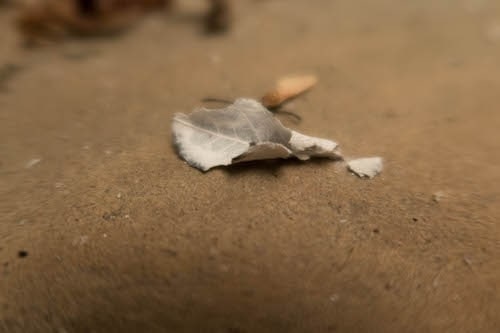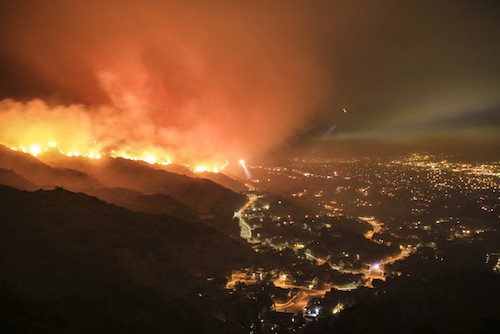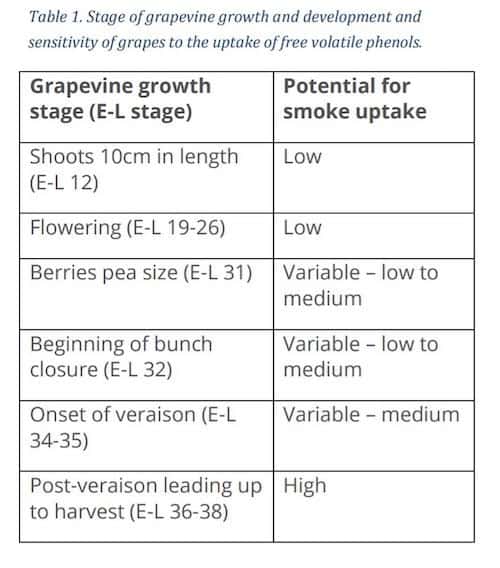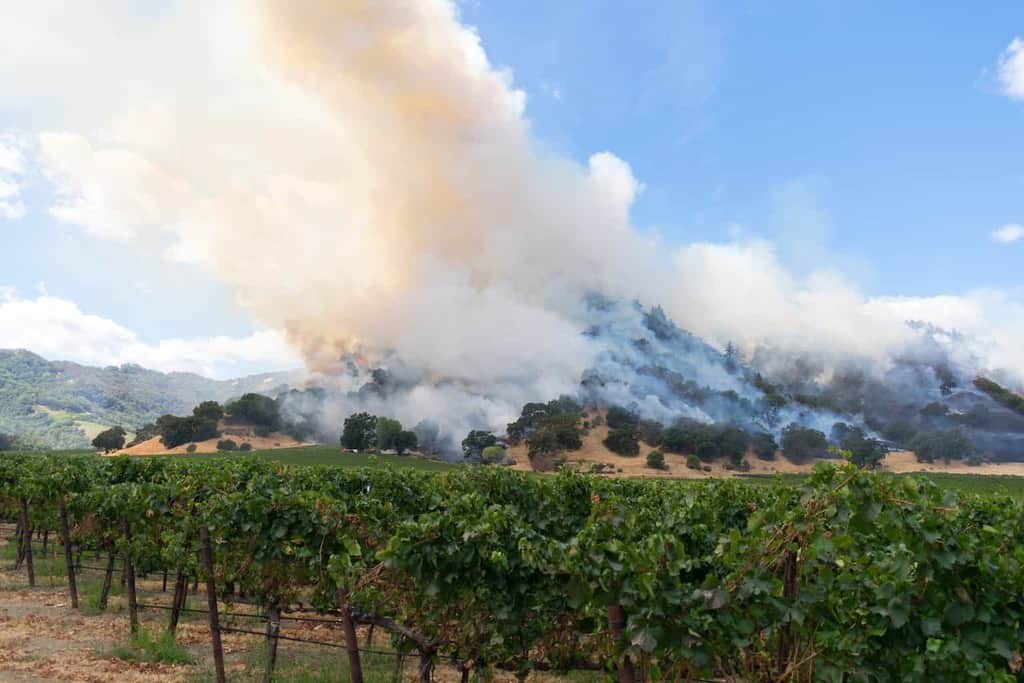As California’s harvest draws down into the safe rest of the cellar, a second year of red and orange wildfire maps blanketed the west coast in a haze of concern…much of it justified. As they say, “where there’s smoke, there’s fire” and so rather than fan the flames with murmurs and whispers of a ruined harvest, let’s look at what exactly smoke taint entails, how wineries and wine growers cope, and (most importantly) how you can breathe easy with your bottles.
Following the Smoke – Fire Season Around the World
It was a tough year. The 2017 season was marked by fire around the world. In Southern Chile, Portugal, Spain, and California winegrowers struggled to make sense of the devastation. In Chile, tree farming of highly combustible timber (pine and eucalyptus specifically) combined with a midsummer drought to fuel a blaze which devastated smaller vineyards and winemakers in early 2017. News of fires raging through Northern California followed the first week of October, sparked by powerlines in the rugged mountains which lend remote beauty to Lake, Napa, Sonoma, and Mendocino counties. Central Portugal and Northern Spain faced their own fiery front a week later in Rías Baixas, Galicia and Dão. Even as I type, concerns about bush fires in Australia are filtering through mere days after rains in California have begun to clear some the 2018 wildfire smoke.
These famed wine regions, with their robust red wines and Mediterranean climates, all share a similar beauty and risk. Hot summers, rainfall concentrated in the winter months, prone to summer droughts; surrounding the sumptuous wines lies the constant risk for blaze.

As the wine world acclimates to changes in weather patterns, the term “fire season” has become akin to hail in Burgundy and bone chilling winters in Germany. What nature’s bounty provides, it seems equally inclined to ruin. Like harvests ruined by cold, wet, and disease, harvests in fire riddled regions face unique challenges. With California’s 2017 wines starting to make their way to market, the worry over smoke taint lingers with the same acrid menace as the smoke from the fires themselves.


Smoke Taint – what it is and how it affects grapes and wine
By and large, a ‘tainted’ wine is one in which an outside impurity makes its way into your glass. You’ve likely heard of cork taint caused by fungi in cork itself. Ladybug taint happens when high numbers of specific ladybug species are harvested along with grapes and compounds make their way into the must. Sure, there are off-wines, but those are chemically endemic to the wine. Taint is the invasion of a wine and its flavors from the outside world – stuff that really shouldn’t make its way into wine.
Smoke taint is one such adulteration. And its on the rise. When wildfires strike, the residue of the smoke can settle on grape vines, leaving a film of volatile phenolic compounds. Where many of wines flavors are derived from grapes’ phenolics, these compounds are unwelcome intruders. And they infiltrate the grape skin, forming bonds with the sugars just inside the skins. These resulting molecules are called glycosides.
Before we keep going, please note that there is not going to be a test. These geek-tastic tidbits clarify smoke taint, but flashcards aren’t necessary. Now, where were we? Right, glycosides.
These glycosides aren’t the problem. They’re bonded and stable. If you popped a grape in your mouth, you wouldn’t notice. The problem is that the acidity produced and released during the crushing, soaking, and fermenting of the must breaks down the glycosides making them unstable.
Now that we know that the compounds formed when smoke settles on grapes is inside the grape skin, it clears up the first question: Can’t they just rinse it off? Clearly not.
Winemakers and wine scientists noted that primary determinants for whether smoke-exposed grapes develop smoke taint are:
- The stage of grapevine growth (Are there grapes? Where are they in development?)
- The grape variety (interestingly, some grapes transmit smoke taint more readily than others)
- Smoke composition
- Length of smoke exposure

All this, and the big question remains: how do winemakers assess the damage?
Clearing the air – how wineries and wine growers deal with smoke taint
Everyone reacts differently in a crisis. When wildfires strike, there’s no sure way to determine (pardon the pun) how the smoke settles. Those glycosides transform into the markers for ashtray aromas in predictable ways, but it all depends on the winemaking method.
The fruit of the vine
Winegrowers don’t have many options. The smoke, once it arrives, is a fact of life. Some growers leave the fruit where is: on the vine, never to make into the bottle. Other growers will sell off to the bulk market. It’s a matter of economics for the agricultural side of the wine industry: can you take the hit, is your crop insured, or do you need to make a living?
Grapes themselves can be treated with ozone to eliminate the precursor glycoside compounds. The innovative technology shows promise but seems to also eradicate the unique flavors which define certain wine styles in regions. Where a slightly smoky Cabernet Sauvignon may have been interesting, the treated grapes produced an utterly pedestrian glass.
In the cellar
For winemakers, three options open a bit. Some winemakers will employ techniques like carbon filters, reverse osmosis, or highly specialized yeasts to minimize the smoke taint. Some winemakers will outright refuse to take those grapes to the cellar. And some brave winemakers call that smoked flavor terroir. Recall that it is the manipulation wine and the break down of glycosides that creates the smoke taint. Thus, minimalists maintain courage in the face of danger.
Take the case of Michael Garofola. The Oregon winemaker works just more than half an acre block of Dolcetto for his label. In September 2017, the Eagle Creek fire set an eerie orange haze in the sky. Michael, in his block of Dolcetto, was working away with a bandana over his face. The fire raged through November as the grapes were going through veraison. Where the vintage may have been a loss, Michael forged ahead. He did as little as possible to the wine and made no apologies. If smoke marked the vintage, then that was an authentic presentation of the time, place and season. In short, the memory of that year lives in the bottle and its unique terroir. Michael wasn’t the only one marching ahead, others in the region did the same with the understanding that, much like Brett, there can be perfection in flaws. (Source)
For the 2017 harvest and Northern California’s wildfires, the prognosis is a touch different. Most of the fruit had been harvested before the fires broke out. Vintners in Spain’s Galicia region reported the same: harvest was well in hand before flames erupted. But what of the wines in tank in those smoked out wineries and cellars?
Good news there, the fermentation process produces quite a bit of carbon dioxide. This carbon dioxide provides something of a protective blanket from smoke according to UC Davis enology specialist Anita Oberholster. (Source). What’s more is that the glycosides formed just inside of the grape skins when smoke settles on grapes in the vineyard don’t form in must, so there’s no stable compound to destabilize. The precursors of smoke taint apparently must exist in the grape itself for the smoke taint to form. No full grapes metabolizing smoke, no smoke taint.
Lingering regret?
And, for you dirt hounds, the volatile phenols of a massive Anderson Valley wildfire in 2008 didn’t carry over into the 2009 vintage. It doesn’t appear that the smoke indelibly imprints on the soil or the vine. As soon as the smoke clears, the risk of smoked wine abates quickly.
Fume vs. Smoke – what to expect when buying
The jury hasn’t returned on the 2017 vintage in Northern California quite yet. There are lab tests and micro fermentation trials which winemakers use to check their wines. Although, where the taint is low, some producers may opt to use mildly tainted wine for second or bulk labels. Overall however, where there’s a high likelihood of smoke taint, grapes are being rejected. One such example is Frey Vineyards, who had to turn away 30 tons of Sauvignon Blanc and 40 tons of Cabernet Sauvignon earlier this year due to smoke taint levels. (Source)
Your best bet? Transparency. Look for wine producers and labels that you know, opt for makers who have a reputation to protect. Deerfield Ranch used an innovative ozone treatment to eliminate volatile phenols from tainted fruit with great success. But when the treated vs. untreated taste test came up, other winemakers noted the wine made from untreated, contaminated grapes tasted more complex. (Source)
At the end of the day, with that bottle in hand, its important to reconcile the truth of a place with the quality of a wine. Australia, Spain, Portugal, California, Oregon, Chile; each a unique place in the world with its own distinct stamp on wine style. When fire season kicks up, there will likely be less wine made. The wines that are made will exude the sheer force of will that drives wine growers and winemakers to persevere.
If you buy a bottle from a smoky vintage and you get an unlikely mouthful of ash, cork the bottle and let the winery or wine shop know. While pushing through, year in and year out, the industry understands that quality matters. Like cork taint and cooked bottles, producers and retailers care about your enjoyment.
There’s no 100% guarantee for the elimination of smoke taint. Your best bet to protect yourself is to drink what you enjoy from makers you trust. Most brands aren’t actively working to let you down.
